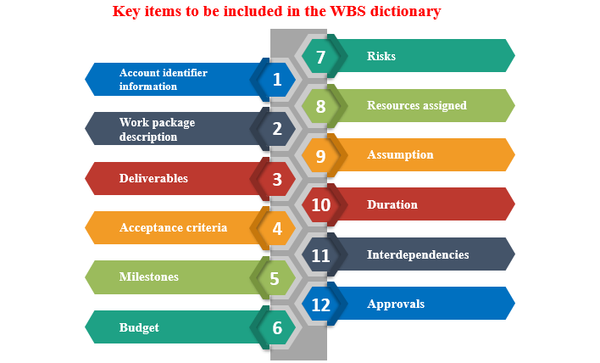WBS Dictionary- The Key to Successful Project Management
WBS Dictionary is a project document that offers a detailed description of the important information for every Element in the WBS and assures that it complies with the 100% Rule. WBS Dictionary is crucial for the baseline and monitoring or measuring the performance scope.

How To Make A WBS Dictionary?
WBS Dictionary can be created after the Work Breakdown Structure is approved. Project Managers lead the creation of the WBS Dictionary, and it is developed by the team members of the project who are SMEs. With the Level 1 WBS Elements, the development approach begins, proceeding down to each Leg and gets terminated with the Work Packages. Following this hierarchical approach helps to ensure that each work within Level 1 is in alignment and complies with the 100% Rule.
Creating And Maintaining A WBS Dictionary
For creating a WBS Dictionary, follow the steps below while using a WBS Dictionary template.

1. Assemble the Project Members and Validate 100% Rule:
Validate the 100% Rule by assembling the project team members (SMEs) and reviewing the WBS. Make sure that the WBS assumptions and logic are clear to everyone. The WBS should be revised based on the SME’s feedback.
2. Create Content for WBS Level 1 Elements :
Follow the minimum topics below and use a template for creating the content for WBS Level 1 Elements:
- Title and ID Code for WBS Level 1 – Identify it as a control account, in case it is one.
- Description – Defining the Work Package boundaries and framing the content scope of the element to make a clear view of the included and excluded scope.
- Deliverables (Primary) – The service, product, or outcome created after completing all the work in the WBS Leg.
- Acceptance Criteria – Physical and functional requirements for meeting customer expectations.
- Budget – Summary budget of the WBS Leg, including the assumptions.
- Milestones – The milestone of the Primary Deliverables, including any constraints, assumptions, and interdependencies.
- Risks – Any key threats to be included with response strategies.
3. Confirm the Elements of Level 1:
Return to the WBS and check if the WBS Level 1 Elements need revision according to the new content created from the WBS Dictionary. And confirm that 100% of the scope of the project is captured by the Level 1 Elements.
4. Create Content for the Remaining Elements :
Use the same template and create similar content for the remaining WBS elements, down to while not comprising the Work Packages. Now adjust the content for reflecting the respective Element Level, such as Level 2, 3, and more.
5. Create Content for Work Package :
Follow the topics and use a template for creating content for each Element of the Work Package:
- Code and Title of the WBS Level 1
- Responsible Individual/Organization – Mentioning the name of the individual or organization responsible for completing the Work Package.
- Description
- Deliverables
- Acceptance Criteria
- Budget
- Milestones
- Risks
6. Validate The 100% Rule :
Validate if the WBS Dictionary adequately captured 100% of the scope required for producing the deliverable. Then, verify and make sure that 100% of the scope is reflected by the WBS Dictionary.
Guidelines For Maintaining A WBS Dictionary:
- The experts strongly recommend that the experts adopt a standard structure to offer detailed information for each of the WBS elements to ensure consistency. Also, it will serve as a template for both the reader and the author.
- The in-depth information provided for WBS elements should be less for the higher in the hierarchy level and more detailed for the elements in the lower level.
- Using the same document for the WBS as well as the WBS Dictionary is a good practice. This will help the stakeholders and project team to easily search for any information. For example, while looking at the WBS, they can get all the information about the WBS right there in the WBS dictionary in the same document.
- The WBS dictionary undergoes constant revision due to ever-changing circumstances. Therefore, reviewing the content of the WBS dictionary should be done frequently to ensure efficient project management.
What Are The Key Items To Be included In The WBS Dictionary?

1. Account identifier information – Include the information about the work package like WBS code, control account ID, work package ID, name of the organization, or individual responsible for completing the work package.
2. Work package description – It contains a detailed description of what needs to be done. It’s the scope of work that is to be done for completing the work package.
3. Deliverables – Define the product, outcomes, or service developed when the work package is complete.
4. Acceptance criteria – It clearly states the physical and functional requirements or conditions the work package is accepted. This is important to meet the demands and quality requirements of customers.
5. Milestones – Here, list all intermediate
6. Budget – It shows the total allocated budget for completing the work package.
7. Risks – Any identified risks or threats along with their response strategies are included here.
8. Resources assigned – It shows the name of the individuals or organizations that will perform the work package activities. There can be an individual name, supplier name, department name, or all of them.
9. Assumptions – It contains the things that may not stand true but is assumed to be true regarding the work package.
10. Duration – It indicates the time it will take to complete and deliver the project work package.
11. Interdependencies – Any dependencies, either successors or predecessors of the work package, must be mentioned in the WBS dictionary.
12. Approvals – Approval details contain the name and designation of the required people for approval of the WBS dictionary. After completing the work package, it must be accepted and approved by the customer with the acceptance date written.
What Are The Different Types Of WBS?
Generally, there are two types of Work Breakdown Structure:
- Deliverables Oriented WBS : A Delivery-Based WBS defines the project’s deliverables (like the product, results, or service) and the scope (like the work to be executed) along with their relationship. The deliverable-based WBS is the most commonly adopted approach.
- Phase Oriented WBS : A Phase-Based WBS demonstrates the deliverables in terms of the actions. It requires the work related to the various WBS elements to be divided into work unique to each WBS Level 1 Element.



